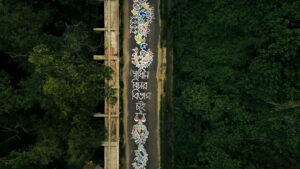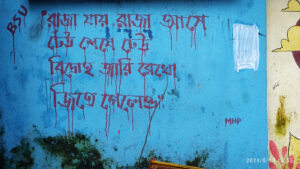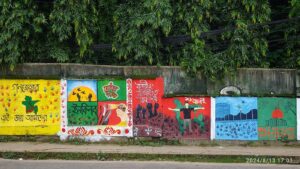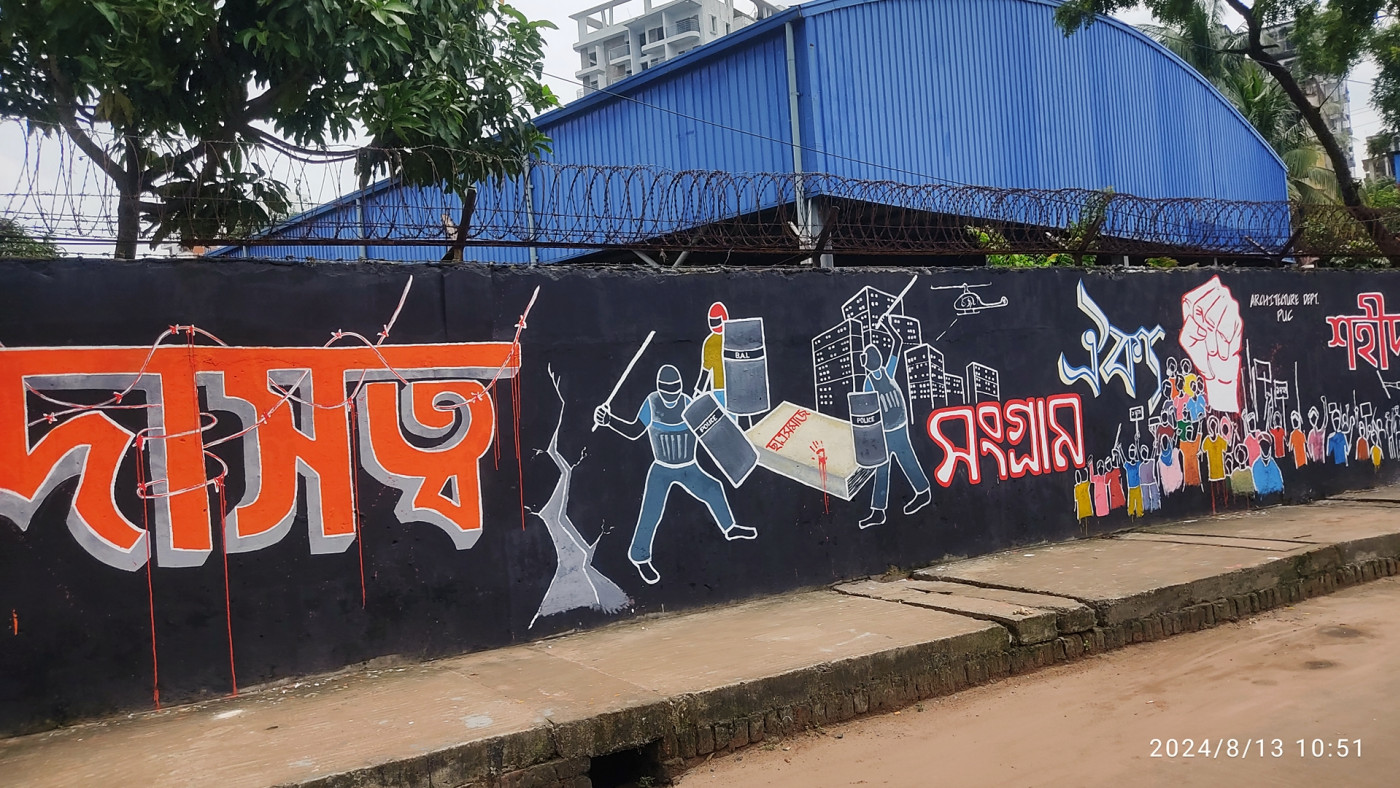Tuhin Sarwar-
As symbols of political and social change, the walls of Chittagong are adorned with various revolutionary images and messages. These artworks convey messages of societal transformation and movements, inspiring the younger generation.
From August 6th, graffiti and wall writing have spread throughout the country. Particularly in Dhaka and Chittagong, streets are covered with various paintings, deep messages, and rebellious cartoons. Students are also restoring early murals that had been erased, documenting every demand, event, and statement from the July-August protests. Their message is clear: “Everything will be remembered.”
Kings come and go,
Waves continue to roll,
Keep the rebellion alive,
Even if you win!
On a blue wall, red strokes of paint make it look as if someone has written in blood! This haunting mural easily grabs attention. Indeed, it’s true. One king leaves, another comes, but the scenario remains unchanged. Only the common people bleed. The artist seems to have used this blood-red color to warn passersby, reminding them not to forget to stay rebellious, even in victory.

Photo: Minhaj Uddin Rakib
I’m referring to Jamal Khan Road in Chittagong. Like the capital Dhaka, Chittagong is also covered with colorful walls and revolutionary writings. As the yellowish hues of the evening settle over this hill-surrounded city, the walls now speak only of freedom. The city that once made me fall in love with its youthful spirit now seems to celebrate a new season of revolution. Every nook and cranny of the city is adorned with vibrant murals. It may feel as if a war-torn city is being redecorated to its liking after the conflict.

Color prints are now visible on every street, every corner, and every alley. Agnijhara (a symbol of revolutionary victory) echoes through every letter, each a testament to revolution and freedom. Rebellion subtly emerges from some walls. Even busy passers-by take notice of these vibrant scenes. Some watch from rickshaws, while others drive them; some stop their cars to observe deeply. Pedestrians too are captivated by the wall art. It feels like the city has been transformed into a new, colorful realm!
Young people are seen on the streets, armed with colored pencils and brushes. Their eyes shine with the joy of victory as they paint the walls with exuberance. Alongside skilled artists, ordinary students are also contributing to this effort. Their work is genuine and impactful. Simple graffiti carries powerful messages. Some are dedicated to spreading new rebellious ideas, while others candidly write about communal harmony. There is a collective anticipation for change reflected in everyone’s eyes, but it’s intertwined with a sense of the past.

One of those involved in the graffiti work is Jisanul Mahmud Raihan. This higher secondary student has been actively participating from the start. During the movement, he continued wall writing. Where he once worked at great personal risk, now he feels a sense of relief and pride. His eyes are fearless and enthusiastic, with no hint of doubt or fear of losing his life. He continues to write the words hidden in his heart on the walls like a free bird. “The colors of victory will reflect in our graffiti as well. The joys and sorrows of revolution will be depicted side by side on the walls,” Raihan says.
Previously, the walls in the Jamal Khan area of Chittagong were adorned with various cartoons and paintings. Pokémon, Nobita, and Ben 10 were among the popular themes. Some of these are still present. These walls were once the backdrop for countless stories, conversations, and songs from students of schools, colleges, and universities. But now, the narrative has changed. Jamal Khan Road has transformed into a new battleground of revolution. Walls now depict tales of rebellion, revolution, and the blood of martyrs. Even gatherings of young people have turned into discussions about each wall.
After the fall of Sheikh Hasina’s government, graffiti began spreading across the country from August 6th. Particularly in Dhaka and Chittagong, streets are adorned with various paintings, deep messages, and rebellious cartoons. Students are also restoring early murals that had been erased, documenting every demand, event, and statement from the July-August protests. Their message remains: “Everything will be remembered.”
So even if a wall is covered with advertisements or is abandoned, artists are at work with their paints and brushes. For instance, at the Rahattarpul intersection in Chittagong on August 10th, two young artists were seen not depicting fiery messages but illustrating Bangladesh’s heritage and the history of the hill tracts.
Moreover, students from Chittagong University’s Fine Arts Department are beautifying the city with their designs on the blacktopped roads. The whole city is immersed in a festive atmosphere due to these artistic endeavors.
In various areas of the city like DC Hill, Chandanpur, Oxygen, Alankar, Pahartali, Chatteshwari, GEC, Dampara, and Bhatiary, impressive murals can be seen. For instance, on Access Road, a youth is erasing bloodstains from a map, while nearby, slogans such as “If you asked for a bribe, you’ll be beaten” and “Listen, rich man, we are many!” can be seen.
The walls feature various slogans like: “When we brought freedom, we reformed,” “A new chapter of history, July 24,” “July stained with my brother’s blood,” “We will change the fate of our country,” “We must build our country ourselves, we must end the servitude of punditry.” The words of Shaheed Mughdho, “Does anyone need water? Water…,” and even references to Jamuna Television’s role are present.
The initiative started with a Facebook post about Chittagong’s renovation and victory graffiti. The post called for removing posters, waste management, and repainting burned walls, which led to a significant response from students.
Seeing the Facebook post, Rubaiyat Naushin (a pseudonym), a first-year student of the Bengali department at Chittagong College, came to paint graffiti on Dampara Road. She brought her own paints and brushes and worked for two days. “I couldn’t join the movement, but I am happy to be part of this work. At least I did something for my country!”
On August 13th, a graffiti campaign was underway on both sides of the walls and the central island on Jaan Alam Dovhash Road. Some came with friends, while others managed the event through Facebook.
Jarin Tasnim, founder of the Facebook group “We Will Build Bangladesh Anew,” mentioned that they have worked on areas like Kazir Dewri, CRB, Gani Bakery, DC Intersection, Lal Khan Bazar flyover, and Access Road. They have personally covered costs and also received financial donations. Many are joining this initiative through Facebook and WhatsApp groups, and Tasnim estimates that over 30,000 students have contributed to painting the city in colors of victory.
Arabic calligraphy is also visible in various parts of Chittagong. On the red wall of the Access Road island, an ayah from Surah Yasin is written in white letters. The meaning, as explained by the artist, Sanjid Ahmed Faruk, is: “Allah is All-Powerful and He is the Protector.”
Faruk, a higher secondary student, says, “Sometimes I do calligraphy with a single verse and other times just with letters. However, verses are more meaningful. I wish to provide the Bengali translation but there isn’t enough space.”
According to him, Arabic calligraphy on the streets is now being appreciated, which was previously unthinkable. Faruk finds freedom in this expression.
At GEC intersection in Chattogram, posters depict the national flag on the damp wall with the names of students who died in the movement. There are poignant slogans and memories, including heavy words like “Where is conscience?”, “Source: Intelligence,” “We are one,” “36 July,” and even the image of Chattogram’s first martyr, Wasim Akram.
Despite the enthusiasm, there are risks involved. Many students expressed their concerns, recalling an incident on August 11th when students at Khagrachari Government College were attacked and beaten while painting graffiti.
There are also reports of a student named Pronoy Chakma being taken from the college campus for painting. The media covered this incident, including details of the student being assaulted.
“But that doesn’t mean we will back down. If we back down, freedom will be lost. The new sunrise we have witnessed will not be disrupted, even if it means giving our lives,” declares university student Turner.



